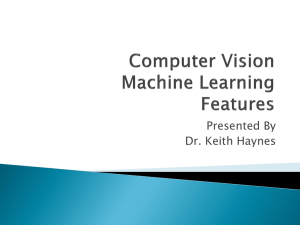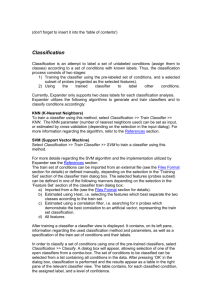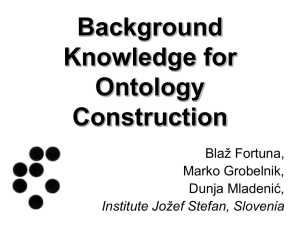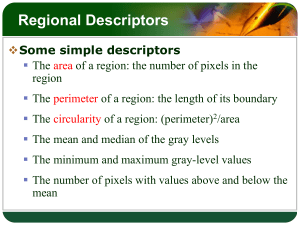Research Journal of Applied Sciences, Engineering and Technology 4(24): 5372-5374,... ISSN: 2040-7467
advertisement
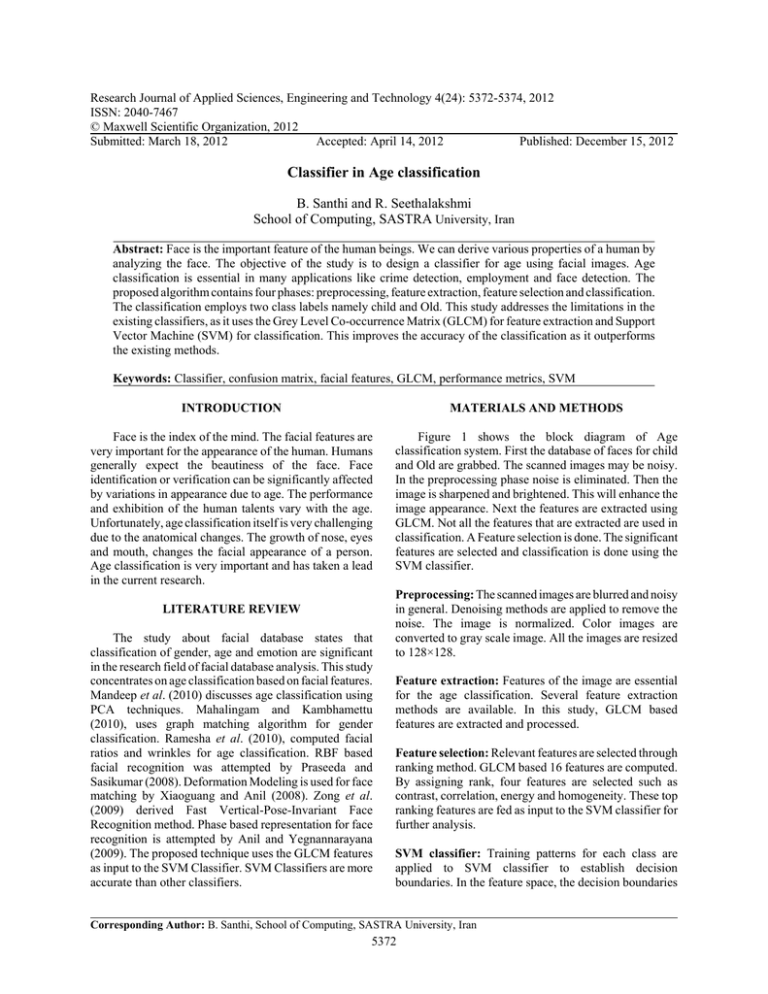
Research Journal of Applied Sciences, Engineering and Technology 4(24): 5372-5374, 2012 ISSN: 2040-7467 © Maxwell Scientific Organization, 2012 Submitted: March 18, 2012 Accepted: April 14, 2012 Published: December 15, 2012 Classifier in Age classification B. Santhi and R. Seethalakshmi School of Computing, SASTRA University, Iran Abstract: Face is the important feature of the human beings. We can derive various properties of a human by analyzing the face. The objective of the study is to design a classifier for age using facial images. Age classification is essential in many applications like crime detection, employment and face detection. The proposed algorithm contains four phases: preprocessing, feature extraction, feature selection and classification. The classification employs two class labels namely child and Old. This study addresses the limitations in the existing classifiers, as it uses the Grey Level Co-occurrence Matrix (GLCM) for feature extraction and Support Vector Machine (SVM) for classification. This improves the accuracy of the classification as it outperforms the existing methods. Keywords: Classifier, confusion matrix, facial features, GLCM, performance metrics, SVM INTRODUCTION MATERIALS AND METHODS Face is the index of the mind. The facial features are very important for the appearance of the human. Humans generally expect the beautiness of the face. Face identification or verification can be significantly affected by variations in appearance due to age. The performance and exhibition of the human talents vary with the age. Unfortunately, age classification itself is very challenging due to the anatomical changes. The growth of nose, eyes and mouth, changes the facial appearance of a person. Age classification is very important and has taken a lead in the current research. Figure 1 shows the block diagram of Age classification system. First the database of faces for child and Old are grabbed. The scanned images may be noisy. In the preprocessing phase noise is eliminated. Then the image is sharpened and brightened. This will enhance the image appearance. Next the features are extracted using GLCM. Not all the features that are extracted are used in classification. A Feature selection is done. The significant features are selected and classification is done using the SVM classifier. LITERATURE REVIEW The study about facial database states that classification of gender, age and emotion are significant in the research field of facial database analysis. This study concentrates on age classification based on facial features. Mandeep et al. (2010) discusses age classification using PCA techniques. Mahalingam and Kambhamettu (2010), uses graph matching algorithm for gender classification. Ramesha et al. (2010), computed facial ratios and wrinkles for age classification. RBF based facial recognition was attempted by Praseeda and Sasikumar (2008). Deformation Modeling is used for face matching by Xiaoguang and Anil (2008). Zong et al. (2009) derived Fast Vertical-Pose-Invariant Face Recognition method. Phase based representation for face recognition is attempted by Anil and Yegnannarayana (2009). The proposed technique uses the GLCM features as input to the SVM Classifier. SVM Classifiers are more accurate than other classifiers. Preprocessing: The scanned images are blurred and noisy in general. Denoising methods are applied to remove the noise. The image is normalized. Color images are converted to gray scale image. All the images are resized to 128×128. Feature extraction: Features of the image are essential for the age classification. Several feature extraction methods are available. In this study, GLCM based features are extracted and processed. Feature selection: Relevant features are selected through ranking method. GLCM based 16 features are computed. By assigning rank, four features are selected such as contrast, correlation, energy and homogeneity. These top ranking features are fed as input to the SVM classifier for further analysis. SVM classifier: Training patterns for each class are applied to SVM classifier to establish decision boundaries. In the feature space, the decision boundaries Corresponding Author: B. Santhi, School of Computing, SASTRA University, Iran 5372 Res. J. Appl. Sci. Eng. Technol., 4(24): 5372-5374, 2012 Input Preprocessing Feature extraction Classification Output Fig. 1: SGAE-work flow diagram separate patterns belonging to different classes. The decision boundary is obtained by two approaches namely statistical approach and discriminant based approach. The probability distribution is used to determine decision boundaries in the statistical approach. In the discriminant based approach, the parametric form of decision boundary is specified and is followed by best decision boundary suitable for the classification of the training pattern. The problem of finding a discriminant function can be formulated as a problem of minimizing a criterion function. Algorithm SGAGE: Input: Database of child and Old images Output: Age classification labels C C C C C C An Image database comprising child images and Old images is created Preprocessing like resizing, normalizing and denoising is done GLCM matrix is computed for each image in the database Using GLCM matrix, GLCM features are extracted. Ranking method is used to remove the irrelevant features SVM classifier is designed to process the features and label the images This algorithm is applied in the derived database. And the performance analysis is done to validate the SGAGE algorithm. The discussion is given in the following section. EXPERIMENTATION AND RESULT ANALYSIS Various Images are selected from the web-site. This study selects 25 child images and 25 old images from the web-site. The experimentation is performed using MATLAB. Images are preprocessed as mentioned in SGAGE algorithm. Features are tabulated in Table 1. The SVM classifier is applied with the training samples and trained using MATLAB function. Then the test images are applied and the class labels are determined. To validate SGAGE algorithm performance analysis is carried out. Confusion matrix is generated and performance metrics such as sensitivity, specificity and accuracy are computed as shown in Table 2. Unknown data is provided to the proposed model to validate SGAGE algorithm. Confusion matrix is created using actual and target output. The matrix contains True Table1: GLCM features of images Images Contrast Correlation Child 0.2072 0.9318 0.2351 0.8657 0.0998 0.9715 0.2522 0.9549 0.0762 0.9116 Old 0.5263 0.8491 0.4221 0.8379 0.3732 0.8796 0.4263 0.8934 0.2254 0.9193 Table 2: Confusion matrix Expected/experimental Child Old Energy 0.1666 0.2792 0.5179 0.3891 0.5498 0.0907 0.1298 0.1344 0.1129 0.1699 Child TP (25) FP (2) Homogeneity 0.9086 0.9090 0.9796 0.9629 0.9640 0.7870 0.8373 0.8581 0.8321 0.9000 Old FN (0) TN (23) Positive (TP), True Negative (TN), False Positive (FP) and False Negative (FN): Sensitivity Accuracy Specificity = TP/ (TP+FN) = 25/25 = 100% = (TP+TN)/ (TP+TN+FP+FN) = 48/50 = 96% = TN/ (TN+FP) = 23/25 = 92% This performance analysis derives 100% Sensitivity; 96% Accuracy; 92% Specificity for the Database. Misclassification may be reduced further by increasing the training set and use other features. CONCLUSION Age classification is playing vital role in many application areas. This study addresses the issue of classifying the old and child images using SGAGE algorithm. Images are processed and GLCM features are extracted which outputs to the SVM classifier for labeling the images. In future wrinkle features and inter ocular distance can be used for classification. This may decrease the misclassification rate. REFERENCES Anil, K.S. and B. Yegnannarayana, 2009. Analytic phasebased representation for face recognition. Seventh International Conference on Advances in Pattern Recognition, pp: 453-456. Mandeep, K., V. Rajeev and N. Nirvair, 2010. Recognition of facial expressions with principal component analysis and singular value decomposition. Int. J. Comput. Appl., (00975-8887), 9(12). 5373 Res. J. Appl. Sci. Eng. Technol., 4(24): 5372-5374, 2012 Mahalingam, G. and C. Kambhamettu, 2010. Age invariant face recognition using graph matching. Fourth IEEE International Conference on Biometrics: Theory Applications and Systems (BTAS), 27-29 Sept., USA, pp: 1-7. Praseeda, L.V. and M. Sasikumar, 2008. RBF based face recognition and expression analysis. Proceedings of World Academy of Science, Engineering and Technology, 32: 589-592. Ramesha, K., K.B. Raja, K.R. Venugopal and L.M. Patnaik, 2010. Feature extraction based face recognition, gender and age classification. Int. J. Comput. Sci. Eng., 02(01S): 14-23. Xiaoguang, L. and K.J. Anil, 2008. Deformation modeling for robust 3D face matching. IEEE T. Pattern Anal., 30(8): 1346-1357. Zong, X.L., Y. Wei-Jyun, C.H. Chian and W. Chin-Song, 2009. Fast vertical-pose-invariant face recognition. Proceedings of the Fourth International Conference on Autonomous Robots and Agents, pp: 613-617. 5374




